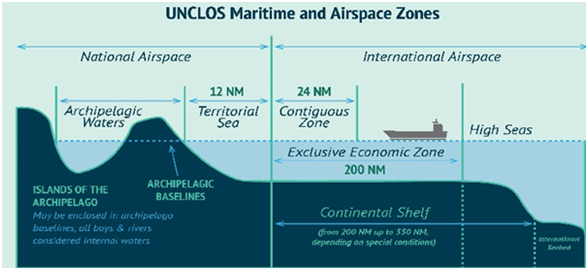

Context
The UN wants to protect the high seas as they make up more than 60% of the world’s oceans and drawn less attention than coastal waters.
About
Need of such treaty
|
Fishing, shipping, tourism and ocean protection are currently controlled by around 20 organizations. However, their regulations only apply to a distance of 200 nautical miles (370 kilometres) from the coast. |
- Out of protection cover:Although the high seas make up more than half of the surface of the Earth and 61% of all oceans, only 1% of international waters are under protection.
- Increasing threats:Illegal fishing, overfishing, new and emerging activities such as geoengineering, and climate change are among the many threats to high seas marine life.
About New Treaty:
- The UN general assembly had decided to convene an Intergovernmental Conference (IGC) in December 2017 to elaborate on the text of the legal instrument for protecting biodiversity in areas beyond national jurisdiction (BBNJ) under
- The treaty has been in the works for years and is supposed to protect species and allocate the oceans’ resources in a sustainable way.
- The IGC held four formal sessions in September 2018, March 2019, August 2019 and March 2022.
- The ambition of the treaty is to reverse the current downward trend in biodiversity and protect marine life, while also guaranteeing safe access to international waters.
- The treaty will help conserve biodiversity in areas beyond national jurisdiction (BBNJ) that lie outside countries’ 322-kilometre exclusive economic zones.

Mapping the High Seas:
- The international waters of the High Seas, which lie outside any country’s exclusive economic zone (EEZ), make up 64% of global ocean and cover 46% of Earth’s surface.
- Nearly half of planet is beyond the reach of any enforceable law or governance.
- It is estimated that just 1.3% of the High Seasis protected, compared to 17% of the land.
What would a High Seas Treaty do?
|
30 by 30 goals:
|
- Body to enforce rules: The high seas treaty, if agreed, would create a new global body to enforce rules laid out to protect about 30% of the world's oceans by 2030.
- Extended law over waters:It would extend international law beyond countries' territorial waters and exclusive economic zones (EEZs), which extend 200 miles from any nation's coastline, to cover a major portion of the currently unprotected waters from threats such as overfishing and unchecked seafloor mining.
- Legal framework:This treaty will provide a first-ever legal framework for the protection of biodiversity in international waters, including the:
- creation of ocean sanctuaries
- environmental rules
- application of Environmental Impact Assessments preceding any human activities on the waters
Significance of Governance
- Economic benefits:The resources of the ocean don’t just sustain coast dwellers, but almost 3 billion people worldwide. The entire sea industry has a worth of $3 trillion (€2.8 trillion) — that’s 5% of the world’s gross domestic product.
- Energy generation:The Ocean isn’t just important for beach tourists and fishers. We also need it in order to generate sustainable wave and tidal energy, as well as for the production of commodities and even medicine.
- Environmental significance:More than half of the total amount of oxygen in our atmosphere is created by creatures in the ocean.
- Welfare: Scientists see a huge potential in the waters for the treatment of diseases.
- For example: Agents used to fight leukemia is derived from water sponge Tectitethyacrypta. The poison of the fish-eating sea snail Conus magus is being used to develop an effective painkiller.
|
UN Convention on the Law of the Sea (UNCLOS):
|

